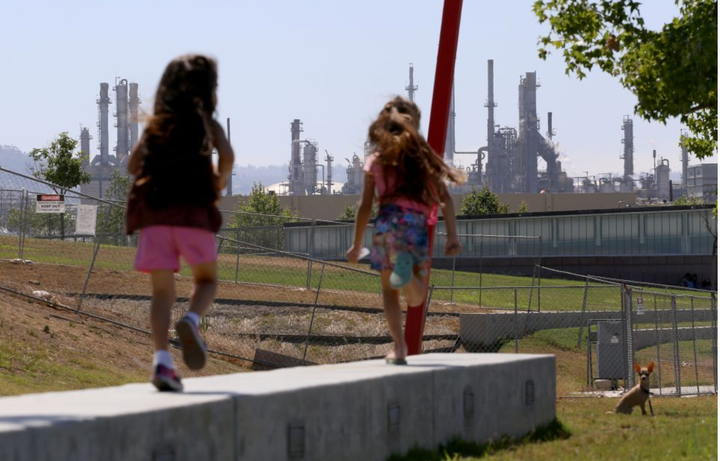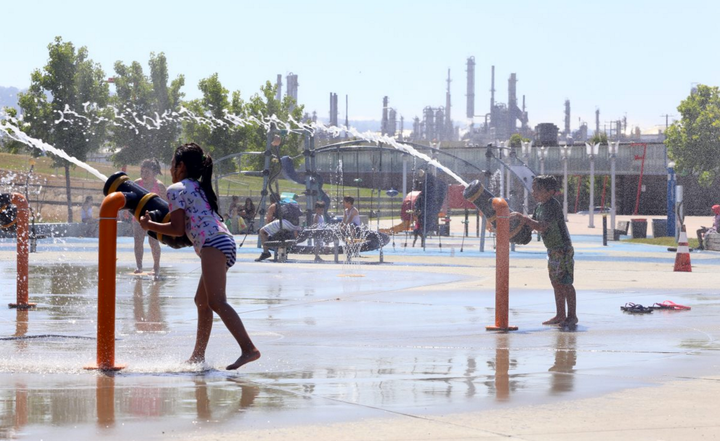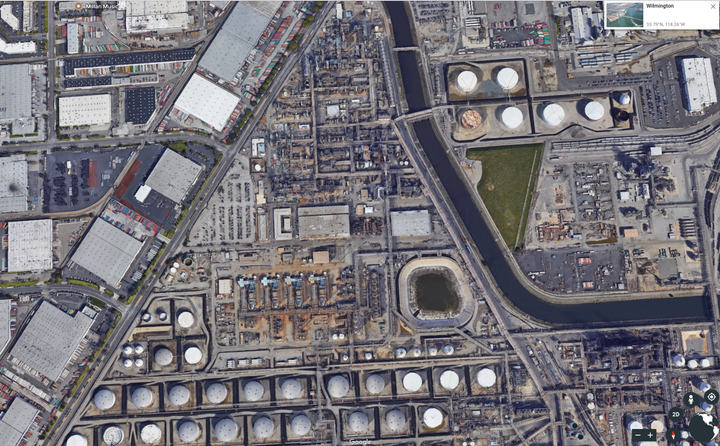
Children at play in Wilmington, California—their neighborhood is adjacent to a major cluster of industry.
Growing up with 12 people packed into a two-bedroom apartment in Wilmington, Magali Sanchez-Hall rarely left the bubble of her south Los Angeles neighborhood.
She assumed everyone lived with chronic coughs, unexplained skin rashes and asthma. Her extended family and friends were all hit with cancers.
“It’s just the way it was,” she said.
Not until Sanchez-Hall left Wilmington—an industrial powerhouse where multiple freeways, the Port of LA, rail spurs, and four oil refineries crowd into in less than 10 square miles—did she began to connect the dots.
The awakening came in her first semester at UCLA, where she was pursuing a master’s degree. A guest lecturer for her environmental law class began a presentation by describing “the most polluted place in America” where taking in a lungful of air was considered a debatable health choice. He called it “ground zero” for industrial pollution.

Magali Sanchez-Hall in front of the Tesoro refinery near her home.
“He began to show slides of this ‘terrible’ place,” Sanchez-Hall said. “I was curious where it would be. But when I saw the pictures, I couldn’t believe it, there was my brother’s house, there was my uncle’s house, there was my church.”
This is a neighborhood that cap and trade left behind. California’s landmark climate change law has done its job in reducing greenhouse gases that drive global warming. The program was renewed by the legislature through to 2030, and signed into law this week, codifying what many see as the state’s international leadership on climate change.
But the climate law promised something else too. Embedded in its enabling language was a pledge not to make things worse in the communities where big polluters operate. Its framers anticipated that, even as cap and trade’s market-based mechanism provides flexibility to industry, it opens the door to a host of unintended consequences. By allowing industries to buy carbon credits or offset projects rather than modernize old equipment, localized pollution would not improve, and could get worse.
None of the refineries contacted commented for this story.
As for Sanchez-Hall, she once again lives in the embrace of her family, fortified with sophisticated air filters in her home and standing orders to close windows and stay inside when one of the local refineries is burning off gas, or flaring. And she maintains a hard rule to never go anywhere without an inhaler, lest one of her kids experience an asthma attack.
“People say, ‘Why don’t you just leave?’” said Sanchez-Hall, a public policy consultant. “Yeah, I could afford to. But what about my mom? What about my brother and his kids? What about the lady who cuts my hair? What about the mechanic who fixes my car? What about the guy who runs the local store? What about all those people?”
This week Gov. Jerry Brown signed into law the extension of the state’s cap-and-trade system, ensuring that the landmark climate law continues until 2030. California’s aggressive efforts to combat global warming have gained international acclaim, and the ambitious goals for greenhouse gas reductions are on track.
But from its origins in 2006, the law creating cap and trade contained another promise: to ensure that air quality in communities in the shadow of industrial polluters would not worsen. By that measure, it has been less successful.
In some cases pollution is pouring out of smokestacks, unabated, because more than three-quarters of the carbon-reduction projects the law allows are taking place out of state. Studies show that air is getting worse in some low-income neighborhoods around the state, from the Bay Area to the Central Valley and south Los Angeles. Rates of asthma and other respiratory ailments are on the rise.
Granted, cap and trade’s primary function is to regulate and reduce planet-warming greenhouse gases. Viewed simply, the 2006 law that created it restricts the amount of greenhouse gases a facility can belch out of a smokestack. The law does not regulate the other pollutants that flow out at the same time.
That doesn’t mean, however, that cap and trade doesn’t concern itself with air pollution. The law directs the state to design a market-based system that will “prevent any increase in the emissions of toxic air contaminants or criteria air pollutants.” Among those toxins are the carcinogen benzene, noxious chemicals such as sulfur dioxide, and particulates damaging to respiratory health.
The wording of the law is the equivalent of the physicians’ admonition to “First, do no harm.”
The state knew all along that the carbon trading system could create “hot spots.” In 2011, the state Air Resources Board established a process under the umbrella of cap and trade to monitor localized air quality impacts as a result of cap and trade. The air board convened an advisory group to devise a plan requiring emitters to quickly reduce local pollution.
The panel has yet to agree on a course of action. An air board spokesman said the group was moving forward with its work.
“Even though there’s this language in the law that tells them to design a system to prevent increased pollution, they’ve said, ‘Don’t worry your little heads, we’ll take care of it.’ They haven’t,” said Brent Newell, legal director for the Center on Race, Poverty & the Environment, which provides organizational and legal assistance to low-income communities.
To some, the impetus to reduce point-source pollution has been overtaken by the air board’s enormously complicated task of getting a first-of-its-kind carbon market up and running.
Dean Florez, who as a state senator voted for the creation of cap and trade, now sits on the air board. He said that in retrospect, it was a mistake to saddle the agency with twin missions to reduce carbon and air pollution. “I think that we piled too much on the air resources board,” he said.
Even though cap and trade is achieving its goals, he said, success now becomes a relative term. “If we are just solving for carbon, those communities are not any better off.”
Former state legislator Fran Pavley, who authored the law birthing cap and trade, said its intent was to was to create a “multi-benefit approach ... As we reduce greenhouse gas emissions, we would also be able to reduce criteria air pollutants which have the localized direct health impacts.”
Pollution control in many impacted neighborhoods has been regulated by local air boards, who can adopt robust policies, or not, in response to local needs. Cap and trade was not meant to replace efforts by state or local air boards to reduce air pollution, Pavley said, but it envisioned the program would bring cleaner air to the low-income neighborhoods located near regulated facilities.
Still there’s no guarantee—even when industries comply with the emissions cap—that the air quality in their proximity will improve. That’s because the system allows companies options: retrofit aging facilities to reduce emissions, purchase permits from the state auction, or buy a certain number of offsets from carbon-reducing projects in California or elsewhere. With more than 75 percent of the program’s offsets paying for out-of-state projects, emissions at some individual facilities here remain unchanged.
The new legislation reduces the percentage of a firm’s greenhouse gas emissions that can be offset, beginning in 2021, and adds a requirement that half the projects take place in California.
For now, at many of the most-polluting smokestack industries, it’s been business as usual.
Recent reports have clarified the state of play, often stating the obvious: Facilities regulated under cap and trade are located in neighborhoods with higher proportions of residents of color and residents living in poverty. And, those neighborhoods are also more likely to have the biggest polluters.
A 2016 report, prepared by researchers from the University of California at Berkeley, University of Southern California, San Francisco State and Occidental College, examined the environmental equity of cap and trade. It tempered the overall good news about statewide greenhouse gas reductions, finding, “…on average, many industry sectors covered under cap-and-trade report increases in localized instate GHG emissions since the program came into effect…”
The report concluded that large industries whose emissions represent public health concerns are the most likely to use offset projects to meet their obligations under the cap-and-trade program.
Another analysis, published in February by the state Office of Environmental Health Hazard Assessment, concluded what common sense would suggest: There is a “strong correlation” between greenhouse gas emissions and emissions of air pollutants among refineries, and, in general, higher greenhouse gas emitters also were higher emitters of other pollutants.
Martha Argüello, executive director of the Los Angeles chapter of Physicians for Social Responsibility, called the latter the “I-told-you-so report,” which affirmed what local residents had been complaining about.
“Often, the data ground-truths the community experience,” she said. “There was a promise with cap and trade not to make things worse. The data shows that’s happening. Promise broken.”

At new Waterfront Park, children play between the Valero and Phillips 66 refineries, right beside the Los Angeles Port.
Betrayal has been the theme from critics of Gov. Brown’s willingness to compromise to get the votes needed to secure cap-and-trade’s extension. The governor toured low-income neighborhoods in the lead-up to the reauthorization vote, promising skeptical activists that areas hard-hit by pollution would receive revenue from the cap-and-trade auction program.
To ease passage of the new cap-and-trade law, Brown and legislators also approved a companion measure—sponsored by Democratic Assemblywoman Cristina Garcia of Bell Gardens—intended to hold polluters accountable for cleaning air in vulnerable communities.
But the Assembly killed a much more stringent version, and what emerged left some environmental justice advocates complaining that it would yield no appreciable benefit. It also would allow local air districts to create pollution trading markets that could permit companies to continue to pump toxics into the air in fence line neighborhoods. On the other hand, the law will greatly expand air pollution monitoring, and it raises the maximum fines levied against industries.
The oil and gas industry was at the negotiating table, strongly opposing aspects of both new laws that sought more control over emitters. Catherine Reheis-Boyd, president of the Western States Petroleum Association, said oil and gas producers and refiners support both enacted measures.
“Local monitoring and community investment are important; as an industry we embrace that,” she said. “There’s more to be done in local communities, we understand that. We do have to reduce criteria pollutants and toxic pollutants.”
Reheis-Boyd would not specify what actions polluting companies would take under the new rules to retrofit facilities, but termed tackling air pollution in the state “very expensive.”
Brown encountered a small group of protesters this week at the signing ceremony for Garcia’s bill, making up his own pro-cap and trade chant to counter theirs.
“Today, we’re taking a step to take the poison out as well as increase the prosperity and the goodies for all,” he said.
Garcia, too, has felt the sting from the environmental justice community. A former teacher who has championed public health issues, she said candidly that she understood their anger.
“There’s more work to be done. I’m going to keep fighting,” she said. “We have left communities like mine behind too long. We get treated like a wasteland. But let’s not be lost in our frustration. I’ve been on the outside my whole life, I’ve been throwing rocks. I understand. I’m not going to pretend this is going to solve all our problems. But this is something.”
Even though greenhouse gas emissions in the state are declining —down 10 percent since peak levels in 2004 —localized pollution is another matter. The February state report studied 10 areas and found that four—Richmond, Oakland, downtown Los Angeles and Fresno—experienced increased pollution since cap and trade was fully implemented in early 2012.
In short, the program is doing global good. Except in communities such as Wilmington, where it isn’t.

A view from above of Wilmington, via Google Earth
Alicia Rivera is a local organizer with Communities for a Better Environment, a California-based environmental justice group. She walks the busy streets in Wilmington and Carson, pushing through creaking wrought iron gates, calling out to calm barking dogs, knocking on doors. To those who answer, she asks, “Is anyone sick?” and people spill out their stories.
For her, every street elicits a litany of medical nightmares. “That house over there, with the white car? The woman has two children, one with asthma and the other with stomach ulcers,” Rivera said. “That one with the beautiful garden? She has a tumor in her head. The brown house? Cancer.”
Should Rivera’s inventory require official confirmation, the neighborhood appears on the state’s CalEnviroScreen maps as a grim sweepstakes winner: It’s in California’s 96th percentile for pollution burden.
These working-class neighborhoods cram together what health researchers term “sensitive receptors”—society’s most medically vulnerable—all in one place, in close proximity to heavily-polluting sites. At one four-way intersection: Low-income and senior housing, an elementary school, a walk-in medical clinic and a daycare center advertising “Open Enrollment: 3- & 4 year-olds.”
It’s two blocks from a refinery and an industrial oil tank farm, against the backdrop of the port’s loading cranes, towering on the horizon like prehistoric birds.
Linda Bassett teaches at a nearby elementary school, where children on the playground can see puffing smokestacks.
“I have kids with nosebleeds, headaches and stomach aches all the time, first graders,” Bassett said. “I have brilliant kids in my classroom. I know that I have bright kids. They are discounted in so many ways. Who cares about their health? Why is it okay? It’s disgusting.”
Schools in the neighborhood have been studied by the state air board out of concern for poor air quality. The county health department regularly sends a specially-equipped medical van to the school to treat students with asthma.
So widespread are respiratory ailments that one grassroots environmental justice group in the area has as its slogan, “We are just trying to breathe.”
Do you like what you are reading? Sign up for CALmatters weekly newsletter.
CALmatters is a nonprofit, nonpartisan media venture explaining California’s policies and politics.